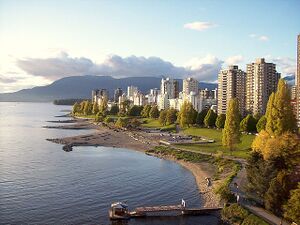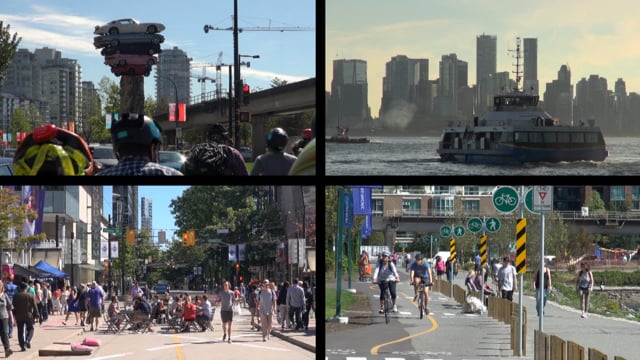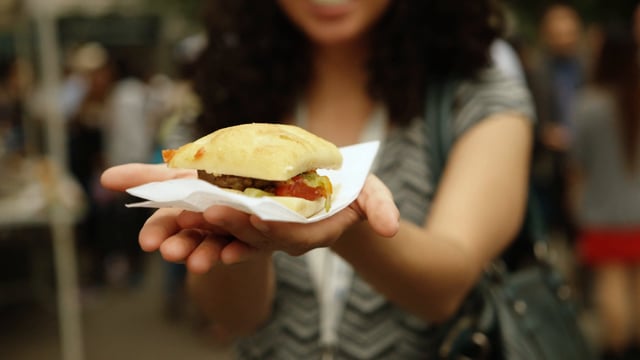
- In Vancouver, Shipping Containers are the New Tool Libraries, Jan 10, 2018[1]
Networks and sustainability initiatives
Greenest City 2020, information from the City of Vancouver
Community energy
Cycling activism
Canadian census data shows that cycling mode share for the city is 3.7 percent as compared to 1.7 percent for the Metro Vancouver area. In neighbourhoods such as Point Grey, Kitsilano, Mount Pleasant and Grandview Woodlands the cycling mode share can be over 10 percent. Within the downtown core, the combined walking and cycling mode is as high as 50 percent.
Vancouver is served by a network of over 300 lane-km of on- and off-road bicycle routes. Most of these routes are local street bikeways (also known as bike boulevards), streets that have extensive traffic calming measures such as traffic circles, and signal control to facilitate crossing of major roads. Neighbourhoods are encouraged to plant and care for the circles and boulevards and add public art along bike routes.
On July 20, 2016, a bicycle sharing system known as Mobi launched in the City of Vancouver. In September 2018, Uber announced plans to launch its dockless electric bicycle sharing system, Jump Bikes in Vancouver.
Food activism
City of Vancouver SharingBackyards
Sharing
Maps: Vancouver's Sharing Cities Network Page including map to find local sharing intiatives near you.vancouver-bc-canada, Shareable
Sustainable transport activism
The SeaBus is a passenger-only ferry service in Metro Vancouver, British Columbia, Canada. It crosses Burrard Inlet to connect the cities of Vancouver (at Waterfront station) and North Vancouver (at Lonsdale Quay). Owned by TransLink and operated by the Coast Mountain Bus Company, the SeaBus forms an important part of the region's integrated public transportation system. In 2023, the SeaBus had a ridership of 5,127,000, or about 14,300 per weekday as of the fourth quarter of 2023.
Public transportation in Vancouver W
Urban sustainability
The City of Vancouver is a member of Metro Vancouver, which provides sustainable regional services to the Greater Vancouver area. The city electrical grid is serviced by BC Hydro, which claims 97.8% of the energy it generates is clean owing to the extensive use of hydroelectric power generation. The City of Vancouver is the greenest city in Canada according to an independent ongoing urban ecological footprint study.
The Greenest City action plan (GCAP) is a City of Vancouver urban sustainability initiative. Its primary mission was to ensure Vancouver would become the greenest city in the world by 2020. The GCAP originated based on the 2009 work of the Greenest City Action Team, a committee co-chaired by Vancouver mayor Gregor Robertson. The GCAP was approved by Vancouver city council in July 2011.
In May 2018, the Zero Waste 2040 Strategy was passed The city began work the same year on decreasing the amount of single-use items distributed in the city. It intends to ban these items by 2021 if businesses do not meet reduction targets. As part of the plan, a ban on plastic straws, polystyrene food packaging and free shopping bags was to go into effect in mid-2019.
In January 2022, the city council passed a regulation mandating that businesses charge a $0.25 fee on single-use cups. This decision was criticized because the fees stayed within the business and were not re-invested in city-wide environmental efforts. On March 28, 2023, the council enacted a by-law that repealed all single-use cup fees.
Vancouverism is an urban planning and architectural phenomenon in Vancouver, British Columbia, Canada. It is characterized by a large residential population living in the city centre with mixed-use developments, typically with a medium-height, commercial base and narrow, high-rise residential towers, significant reliance on mass public transit, creation and maintenance of green park spaces, and preserving view corridors. The architect Bing Thom described Vancouverism this way:
It's a spirit about public space. I think Vancouverites are very, very proud that we built a city that really has a tremendous amount of space on the waterfront for people to recreate and to enjoy. At the same time, False Creek and Coal Harbour were previously industrial lands that were very polluted and desecrated. We've refreshed all of this with new development, and people have access to the water and the views. So, to me, it's thisidea of having a lot people living very close together, mixing the uses. So, we have apartments on top of stores. In Surrey we have a university on top of a shopping centre. This mixing of uses reflects Vancouver in terms of our culture and how we live together.
An important aspect to note is that Vancouverism is an ideal that was developed in Vancouver but is not present in all regions of the city. Additionally, while outlying regions of Metro Vancouver, such as Surrey, have adopted aspects of these ideals, they did not originate outside the city of Vancouver.
Vancouver has been repeatedly ranked among the most livable cities in the world. An article in San Francisco Planning and Urban Research Association has taken note of Vancouver's approach to new development and view corridors and asks if San Francisco should pursue similar direction. However, Vancouver's planning process has come under criticism for its unpredictability, lengthy approval process, lack of transparency, lack of public engagement, the repetitiveness of the built forms it produces, and the potential for the process to involve corruption.
Resources
Video
Past events
2016
Aug 13 Bike to Shop Day
2015
November 8 Great Climate Race, a run/walk to crowfund for local solar energy
June 6 100in1day Vancouver, transform your city
May 27 Feeding the 5000 Vancouver
Homelessness in Vancouver
Homelessness is a social crisis that has been rapidly accelerating in the Canadian city of Vancouver, British Columbia, over the last decade. According to the United Nations, homelessness can either be relative or absolute. Absolute homelessness describes people living in absence of proper physical shelter. Relative homelessness describes people living in poor conditions of health or security, including an absence of both personal safety and steady income despite having physical shelter to reside in. As of 2023, roughly 2,420 people in Vancouver are subject to one of these types of homelessness, or are transitioning between them.
Homelessness as a social issue in Vancouver originated from federal funding cuts to affordable housing. After market housing increased, the cost of housing became one of Vancouver's main causes of homelessness, alongside lack of income. The homeless population in Vancouver is subjected to high amounts of crime-related victimization. There have been several approaches to reducing the homeless population in Greater Vancouver by the city and other organizations. Beginning in 2020, the rate of homelessness in Greater Vancouver has greatly increased, with a 32% increase documented between a three-year period from 2020 to 2023. British Columbia, as the only province without a deadly winter season (in southwestern coastal areas), sees many migrate from other provinces.
About Vancouver
Vancouver ( van-KOO-vər) is a major city in western Canada, located in the Lower Mainland region of British Columbia. As the most populous city in the province, the 2021 Canadian census recorded 662,248 people in the city, up from 631,486 in 2016. The Metro Vancouver area had a population of 2.6 million in 2021, making it the third-largest metropolitan area in Canada. Greater Vancouver, along with the Fraser Valley, comprises the Lower Mainland with a regional population of over 3 million. Vancouver has the highest population density in Canada, with over 5,700 people per square kilometre, and fourth highest in North America (after New York City, San Francisco, and Mexico City).
Vancouver is one of the most ethnically and linguistically diverse cities in Canada: 49.3 percent of its residents are not native English speakers, 47.8 percent are native speakers of neither English nor French, and 54.5 percent of residents belong to visible minority groups. It has been consistently ranked one of the most livable cities in Canada and in the world. In terms of housing affordability, Vancouver is also one of the most expensive cities in Canada and in the world. Vancouverism is the city's urban planning design philosophy.
References








